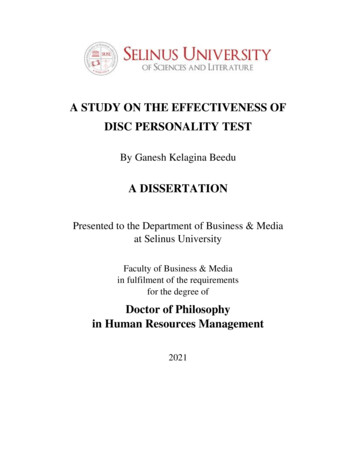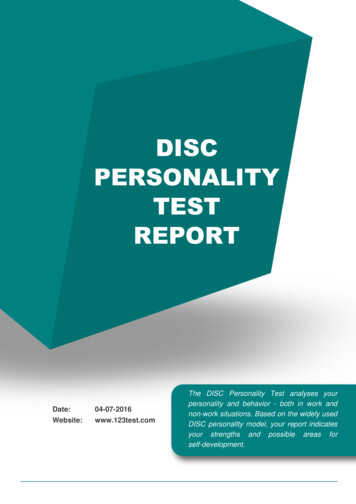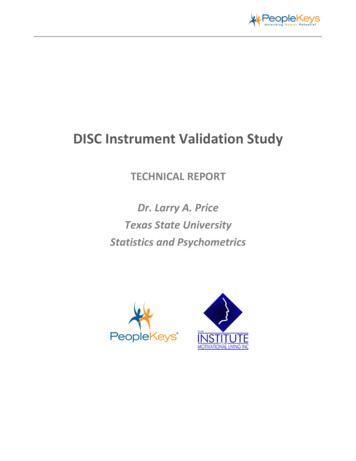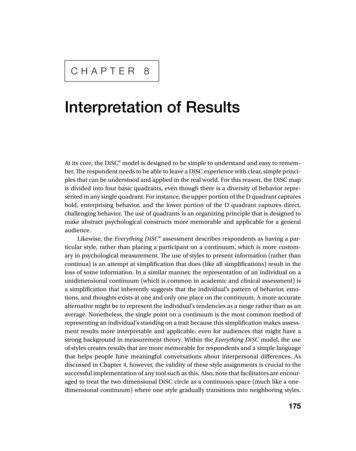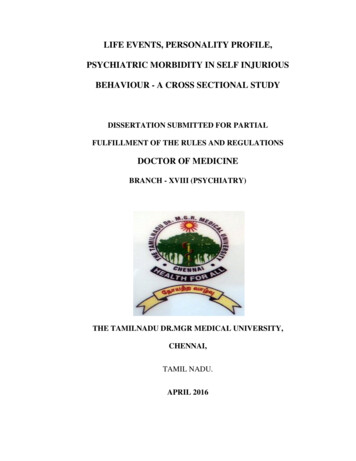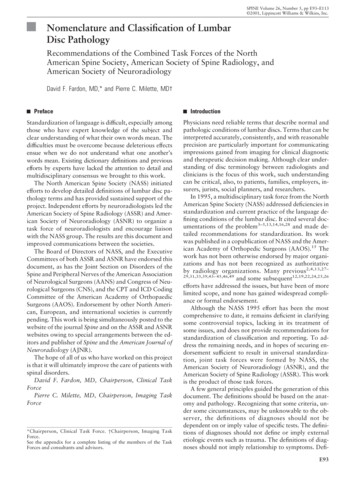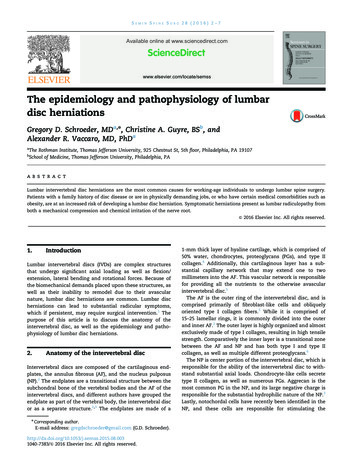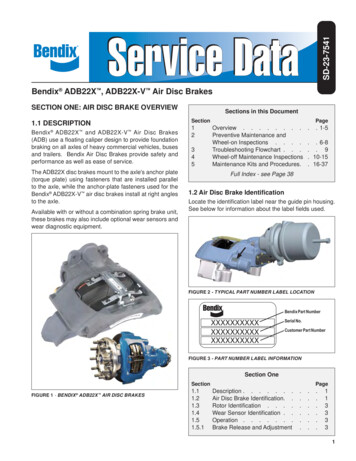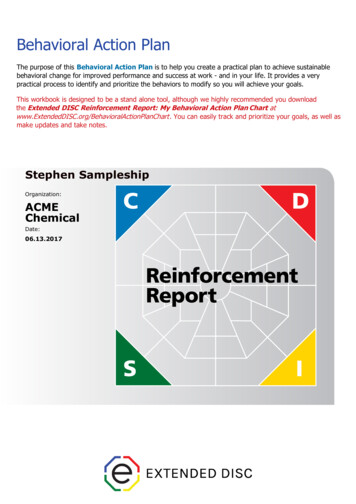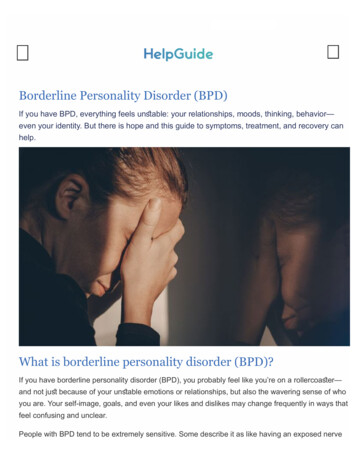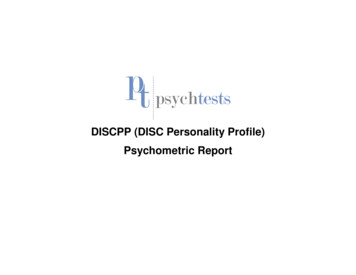
Transcription
DISCPP (DISC Personality Profile)Psychometric Report
Psychometric ReportDISCPP (DISC Personality Profile)Table of ContentsTest Description . 5Reference . 5Vitals . 5Question Type . 5Test Development Procedures. 5Test History . 8Operational Definitions . 9Test Research and Rationale. 9Data Collection - Methodology . 10Limitations of Study . 11Sample Description . 12Descriptive Statistics . 14Normative Information . 15Percentiles - General Population . 15Percentiles – Women . 16Percentiles – Men . 17Percentiles – Below 18 age group . 18Percentiles – 18 to 29 age group . 19Percentiles – 30 to 39 age group . 20Percentiles – 40 age group . 21Descriptive Statistics: Graphical Results . 22EEOC Compliance Statistics. 24Group Comparisons: Gender . 25Gender Analysis . 26Copyright 2016 PsychTests AIM, Inc
Psychometric ReportDISCPP (DISC Personality Profile)Gender Analysis – Graphical Results . 27Group Comparisons: Age. 29Age Group Analysis . 34Age Group Analysis – Graphical Results . 35Group Comparisons: Disability. 37Disability Analysis . 39Disability Analysis – Graphical Results . 40Group Comparisons: Ethnicity . 42Ethnicity Analysis . 56Ethnicity Analysis – Graphical Results . 57Reliability Analysis . 59Pearson’s Correlations . 60Criterion Validity Analysis (concurrent validity) . 61Comparison variable: Working with others . 61Re-sampled Analysis . 67Comparison variable: Working with others – Graphical Results . 71Comparison variable: Desire to be liked by others . 73Re-sampled Analysis . 80Effect Size and Power: . 80Comparison variable: Desire to be liked – Graphical Results . 84Comparison variable: Ability to make tough decisions . 86Re-sampled Analysis . 90Effect Size and Power: . 90Comparison variable: Ability to make tough decisions – Graphical Results . 94Comparison variable: Approach to conflict . 96Copyright 2016 PsychTests AIM, Inc
Psychometric ReportDISCPP (DISC Personality Profile)Re-sampled Analysis . 101Effect Size and Power: . 101Comparison variable: Approach to conflict – Graphical Results . 105Comparison variable: Conflict-resolution strategy . 107Re-sampled Analysis . 112Effect Size and Power: . 112Comparison variable: Conflict-Resolution Strategy – Graphical Results . 116Comparison variable: Work Situation . 118Comparison variable: Work Situation – Graphical Results . 120Comparison variable: Methodical approach to work . 122Re-sampled Analysis . 126Effect Size and Power: . 126Comparison variable: Methodical approach to work – Graphical Results . 130Annexes . 132Annex 1 – Means and standard deviations for Gender . 132Annex 2 – Means and standard deviations for Age . 133Annex 3 – Means and standard deviations for Disability . 134Annex 4 – Means and standard deviations for Ethnicity . 135Annex 5 – Means and standard deviations for Working with others . 136Annex 6 – Means and standard deviations for Desire to be liked by others . 137Annex 7 – Means and standard deviations for Ability to make tough decisions . 138Annex 8 – Means and standard deviations for Approach to conflict . 139Annex 9 – Means and standard deviations for Conflict-resolution Strategy . 140Annex 10 – Means and standard deviations for Work Situation . 141Annex 11 – Means and standard deviations for Methodical approach to work . 142Copyright 2016 PsychTests AIM, Inc
Psychometric ReportDISCPP (DISC Personality Profile)Test DescriptionReferenceJerabek, I., & Muoio, D. (2013). DISCPP (DISC Personality Profile). Montreal, Quebec, Canada: PsychTests AIM Inc.Vitals This test contains 193 questions.It is recommended for assessing a person’s personality, to be used as a supplemental tool to standard hiring processes or for creating workteams.The test is available online. A paper-pencil version is not available.Scoring and interpretation are computer-generated by system-expert and AI algorithms based on rules developed by subject matter experts(SMEs).Norms for different industries and the general population are available in the benchmark report available to professional users. Clients alsohave the ability to create custom benchmarks.Question TypeThis test uses self-report (3-point Likerts) and scenario/multiple choice type questions. The questionnaire is interactive - test-takers drag and droptheir responses to questions into the appropriate box.Note: In order to protect our intellectual property – due to recurring issues of plagiarism - we do not disclose which items are linked to whichscales, nor do we provide item-total correlations.Test Development ProceduresPhase I: Test design and initial launch1) Define test concept2) Research available literature3) Develop a pool of questions4) Eliminate extraneous questions through debate of SMEsCopyright 2016 PsychTests AIM, Inc
Psychometric ReportDISCPP (DISC Personality Profile)5) Assign weights to questions and answer options through debate of SMEs6) Develop scoring system7) Develop interpretation of test results8) Quality assurance testing9) Launch on Queendom and PsychTests10) Opt-in data collection, feedback from users (face validity)Phase II – Preliminary statistical analysis1) Preliminary statistical analysis on small pool of respondentsa. Descriptive statistics (distribution, frequencies, means, variability, percentiles)b. Preliminary reliability and validity analysis (split-half, coefficient alpha, item-total correlations, inter-item correlations and co-variances)c. Factor analysis (exploratory)2) Addition, removal, or modification to questions based on statistical findings3) Quality assurance testing4) Re-launch on Queendom and PsychTestsPhase III – Large-scale statistical analysis1) Large-scale statistical analysisa. Descriptive statistics (distribution, frequencies, means, variability, percentiles)b. Exploratory analysis (correlations, ANOVAs, ANCOVAs, t-tests)c. Reliability analysis (Cronbach’s alpha)d. Validity analysis: (Note: Results of validation questions serve as a revision basis)Copyright 2016 PsychTests AIM, Inc
Psychometric ReportDISCPP (DISC Personality Profile)i. Content validityii. Criterion-related validity (concurrent validity and method of contrasted groups)iii. Internal consistency: item-total correlations, inter-item correlations and covariances; convergent and discriminant validity)2) Re-evaluation of validity and reliability evidence3) In some cases, revision of test items and test structure4) Re-launch of revised version of the test5) Note: Statistics are run on each test on a bi-annual basisCopyright 2016 PsychTests AIM, Inc
Psychometric ReportDISCPP (DISC Personality Profile)Test HistoryThe first version of DISC was developed in 2012 by Ilona Jerabek, Ph.D. and Deborah Muoio. After collecting data for a year, the test was revisedbased on the statistics (reliability, factor analysis). The revised version of DISC was released in 2014. With the following changes: Certain questions were reworded to make them easier to comprehend.Based on the results of the factor analysis, some questions were added/removed from the four factors (Dominance, Influence,Supportiveness, Conscientiousness).Seventeen questions were added; nineteen were dropped due to poor reliability.A new section was added to the report in which we compare the traits a person currently possesses, and the traits he or she would like toimprove/develop (i.e. current self vs. ideal self).The four over-arching factors are calculated using scales.The following scales share questions:a.b.c.d.e.f.Dominance and Influence (6 items)Dominance and Supportiveness (3 items)Dominance and Conscientiousness (6 items)Influence and Supportiveness (6 items)Influence and Conscientiousness (2 items)Supportiveness and Conscientiousness (4 items)Copyright 2016 PsychTests AIM, Inc
Psychometric ReportDISCPP (DISC Personality Profile)Operational Definitions1) Dominance: Individuals who score high on this trait show a great deal of determination and a strong drive to succeed. They fearlessly take onchallenges, are highly ambitious, and are always focused on success.2) Influence: Individuals who score high on this trait are gregarious and sociable. They enjoy being around people and tend to have a great dealof charisma that draws others to them. They are always full of ideas and tend to bring enthusiasm and energy to any group or project they takeon.3) Supportiveness: Individuals who score high on this trait are committed to doing their job well. They can be relied upon to put in a wholehearted effort into every project, and are dependable and loyal employees. They are considerate of others needs, helpful, and easy to workwith.4) Conscientiousness: Individuals who score high on this trait take their work very seriously. They tackle projects carefully and systematically,always making sure that every detail is taken care of to the best of their ability. They can be relied on to provide top quality work.Test Research and RationaleThis personality test is based on the original behavioral theories of William Mouton Marston (1928), and the subsequentpsychological inventory known as DISC , first developed by John G. Geier in 1958. The four personality factors that form the basisof this version of the assessment include Dominance, Influence, Supportiveness, and Conscientiousness. Marston believed thatnearly everyone possesses each of these four characteristics to varying degrees, creating a unique personality blend with differentstrengths and challenges.References Ritchey, T (2002) I’m Stuck, You’re Stuck. San Francisco, CA: Berrett-Koehler Publishers, Inc.Rohm, R. A. (1993) Positive Personality Profiles. Mariette, GA: Personality Insights Inc.Straw, J. (2002) The 4-Dimensional Manager. San Francisco, CA: Berrett-Koehler Publishers, Inc.Copyright 2016 PsychTests AIM, Inc
Psychometric ReportDISCPP (DISC Personality Profile)Data Collection - MethodologyDISC was released on http://www.queendom.com and http://testyourself.psychtests.com/ for data collection in order to further validate the scales.Test-takers accessed the test via a link promoted on the homepage or in the test listings. The test was offered free of charge. The subjectsreceived a free Summary report when they completed the assessment and the validation questionnaire. A Full test report is offered for a fee. Thesample was uncontrolled; the subjects self-selected to take the assessment. Data was collected from 2012 to 2015.Subjects who completed the test had the option to participate in the validation study and were not financially compensated for their participation.Declining to participate in the validation study had no impact on the procedure – everyone, regardless of their participation in the validation study,received the free Summary report. All validation items were gathered through self-report. All items on the validation questionnaire were optional,and the subjects could select the “I prefer not to answer” option for each question.Please note that T-test and ANOVA analyses are dependent on sample size. Therefore, a seemingly large difference between two groups may notshow statistical significance because of a group’s small sample size. By the same token, with very large groups, small but systematic differencesbetween groups may be statistically significant without having any noticeable practical impact. Effect sizes are reported in relevant analyses.With regards to validation questions where the number of subjects in the validation sample was not equally balanced (i.e. the n for some groupswas very high), a smaller, random sample was selected from the larger groups whenever possible, in order to level out the Ns and conduct theanalyses effectively.Note: Psychometric reports are available to all clients upon request.Copyright 2016 PsychTests AIM, Inc
Psychometric ReportDISCPP (DISC Personality Profile)Limitations of Study1) Subjects self-selected to take the test, which could create a biased sample.2) Test-takers’ responses to test questions and validation questions are in self-report format, which can result in inaccuracies, and an under orover-estimation of their abilities, skills, or behavior.3) Sample size may not be large enough to generalize to population.4) Given that the test-takers self-selected to take the test, we do not have the ability to run test re-test reliability.Copyright 2016 PsychTests AIM, Inc
Psychometric ReportDISCPP (DISC Personality Profile)Sample DescriptionSample size: 5,325 subjectsGender distribution: Women: 3,109 subjects (58.4%), Men: 1,315 subjects (24.7%), Unknown: 901 subjects (16.9%)Age distribution:Below 18 (n 1073) (20.1%)40 (n 563) (10.6%)18-29 (n 2074) (38.9%)Unknown (n 1158) (21.7%)30-39 (n 457) (8.6%)Ethnicity distribution:Asian (n 711) (13.3%)Middle Eastern (n 71) (1.3%)Black (n 165) (3.1%)Native American (n 36) (0.7%)Caucasian (n 2,277) (42.8%)Two or more of the above (n 164) (3.1%)Hispanic (n 193) (3.6%)Other (n 97) (1.8%)Jewish (n 26) (0.5%)Unknown (n 1585) (29.8%)Education distribution:Grade school (n 130) (2.4%)Associate’s degree (n 147) (2.8%)Some high school (n 388) (7.3%)Bachelor’s degree (n 675) (12.7%)High school (n 818) (15.4%)Master’s degree (n 385) (7.2%)Junior College (n 813) (15.3%)Ph.D./Doctoral degree (n 74) (1.4%)College (n 398) (7.5%)Unknown (n 1404) (26.4%)Technical/Trade school (n 93) (1.7%)Copyright 2016 PsychTests AIM, Inc
Socio-economic Status distribution:Independently wealthy (n 75) (1.4%)Lower middle level ( 25 000 to 50 000) (n 542) (10.2%)Upper level ( 100 000 or more) (n 253) (4.8%)Lower level ( 20 000 to 25 000) (n 214) (4%)Upper middle level ( 75 000 to 100 000) (n 395) (7.4%)Lowest level ( 20 000 or less) (n 477) (9%)Middle level ( 50 000 to 75 000) (n 595) (11.2%)Unknown (n 2774) (52%)
Psychometric ReportDISCPP (DISC Personality Profile)Descriptive StatisticsSkewnessKurtosis(Std. Error:.034(Std. Scale RangeMinimumMaximumMeanStd.DeviationDominance53250 to 100492.0738.54Influence53250 to 1002.7992.83Supportiveness53250 to 1001.05Conscientiousness53250 to 1001.95ScalesCopyright 2016 PsychTests AIM, Inc
Psychometric ReportDISCPP (DISC Personality Profile)Normative InformationPercentiles - General 5.2678.73Copyright 2016 PsychTests AIM, Inc
Psychometric ReportDISCPP (DISC Personality Profile)Percentiles – 8.42Copyright 2016 PsychTests AIM, Inc
Psychometric ReportDISCPP (DISC Personality Profile)Percentiles – 98Copyright 2016 PsychTests AIM, Inc
Psychometric ReportDISCPP (DISC Personality Profile)Percentiles – Below 18 age 7.80Copyright 2016 PsychTests AIM, Inc
Psychometric ReportDISCPP (DISC Personality Profile)Percentiles – 18 to 29 age 7.69Copyright 2016 PsychTests AIM, Inc
Psychometric ReportDISCPP (DISC Personality Profile)Percentiles – 30 to 39 age 760.8969.3061.398559.0064.107
Test Research and Rationale . This personality test is based on the original behavioral theories of William Mouton Marston (1928), and the subsequent psychological inventory known as DISC , first developed by John G. Geier in 1958. The four personality factors that form the basis
